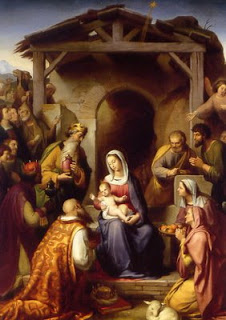On the occasion of Christmas, in the midst of merriment and fun brought in by fantastical Santa Claus, his much awaited gifts which makes every child anxious and special, the air of Religion and Spirituality cannot be missed. Inspite of all partying & celebrations, the worshipping of the birth of a Man who gave a legend, A God, lovingly called Jesus to this world thousands of years back maintains the charm of mankind's faith to this day.
There are beautiful decorations of Star lanterns in every house and street as well as depictions of Jesus's birth in cribs made collectively by young & old, man & woman with reverence. While the auspicious episode of Jesus's birth is mainly depicted by showing infant Jesus in arms of Mother Mary radiating divine aura, there is very less written and spoken of the Star of Bethlehem also called the Christmas star revealed the birth of Jesus to the Biblical Magi.

Many Christians see the star as a miraculous sign to mark the birth of the Christ. Some theologians claimed that the star fulfilled a prophecy.
Astronomers have made several attempts to link the star to unusual astronomical events, such as a conjunction of Jupiter and Venus, a comet or a supernova.
Some modern scholars do not consider the story to be describing a historical event but a pious fiction created by the author of the Gospel of Matthew.
We really don’t know the names of the magi because the Bible doesn’t tell us. In fact, the Bible is silent on how many wise men visited Jesus. However, tradition has it that the three wise men who came to seek and honour the infant Jesus. The three wise men, also known as magi, were men belonging to various educated classes. Our English word magician comes from this same root. But these wise men were not magicians in the modern sense of sleight-of-hand performers. They were of noble birth, educated, wealthy, and influential.
They were philosophers, the counselors of rulers, learned in all the wisdom of the ancient East.
They had apparently studied the Hebrew Scriptures and found there a clear transcript of truth. On the night of Christ’s birth, a mysterious light appeared in the sky which became a luminous star that persisted in the western heavens. Impressed with its import, the wise men turned once more to the sacred scrolls. As they tried to understand the meaning of the sacred writings, they determined to go in search of the Messiah. Like Abraham, they knew not at first where they were to go, but followed as the guiding star led them on their way.
The tradition that there were three wise men arose from the fact that the Bible mentions three gifts, gold frankincense and myrrh. In about the 8th century the names of three Magi—Bithisarea, Melichior, and Gathaspa—appear in a chronicle known as the Excerpta latina barbari. They have become known most commonly as Balthasar, Melchior, and Gaspar (or Casper). According to Western church tradition, Balthasar is often represented as a king of Arabia, Melchior as a king of Persia, and Gaspar as a king of India.
The Adoration of the Magi—i.e., their homage to the infant Jesus—early became one of the most popular themes in Christian art.
The term “wise men” appears 44 times in the Bible, and the meaning varies somewhat.
It has also been suggested that, In addition to the honor and status implied by the value of the gifts of the magi, scholars think that these three were chosen for their special spiritual symbolism about Jesus himself—gold representing his kingship, frankincense a symbol of his priestly role, and myrrh a prefiguring of his death and embalming.”
Some early church history writings claim that the three named Magi came together years later to celebrate Christmas together, shortly before they died. A delicious meal, the laughter of old friends, and a fragrant incense burning to remind them all of that one, incredible journey when they carried gold, frankincense, and myrrh to a newborn king.
